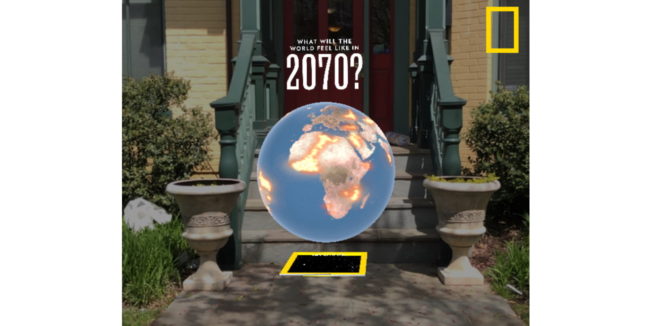National Geographic is accompanying its April 2020 Earth Day issue with its first-ever augmented reality-enabled cover, which unlocks an AR experience on Instagram.
The publisher teamed up with Facebook’s Spark AR platform on the initiative, which Nat Geo pointed out uses the front-facing camera, while most AR experiences use the selfie camera.
“We have been excited about AR and immersive storytelling for a long time, but it’s been largely inaccessible to a lot of people,” Nat Geo director of Instagram Josh Raab said. “This will be available to everybody, not just Nat Geo followers.”
The AR experience brings the issue’s cover to life in order to share a cautionary outlook of climate change using projected climate data for 12 key cities and depictions of what those cities may feel like 50 years from now.
People reading the Nat Geo article via their phones can click on the yellow-and-black globe icon to open the interactive experience via their Instagram apps, or Instagram users can access it by opening up filters in their cameras and searching for “The World in 2070.”

A physical magazine cover is not necessary to access the AR experience. Opening it “generates a digital version of the cover,” Raab said. “Place that cover on any flat surface, or the Instagram app will scan the room, find a flat surface and size and place the cover.” Users can also control the size of the cover by pinching their fingers.
Once set, clicking on the cover results in a globe rising out of the cover and the headline, “What the world will feel like in 2070.”
Raab added, “It’s all 360. People can walk around the earth and scale it to any size. The earth rotates, clouds move freely and we even added some stars in the background.”
Yellow nodes will appear on 12 cities around the globe, and clicking them will bring up current climate data for each city: low and high temperatures in the summer and winter, and average annual precipitation.
A line is then drawn from the selected city to a city that is projected to have the same climate in 50 years. For example, according to projections, Los Angeles will feel in 2070 like Quezzanne, Morocco, does today.
There are two cities for which no 2070 projections will appear—Hanoi (Vietnam) and Kuwait City—because there is currently no location on the planet that feels the way they are projected to feel in 50 years.
The 12 cities included in Nat Geo’s AR experience are: Chennai, India; Hanoi; Istanbul; Jakarta, Indonesia; Kinshasha, Democratic Republic of the Congo; Kuwait City; Lima, Peru; London; Los Angeles; Miami; St. Petersburg, Russia; and Santiago, Chile.








